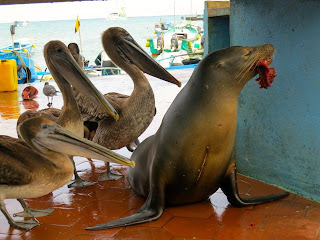When this one came by it poohed on Frankie! Mummy said that was good luck. Splat ha ha good luck Frankie!
 |
| "It's mine, you can't have it! |
 Pelicans are really greedy and even try to eat whole fish all at once! This one had a big chunk of fish head in its mouth.
Pelicans are really greedy and even try to eat whole fish all at once! This one had a big chunk of fish head in its mouth.
On another day, we all saw a big pelican on the side of the road and it had something in his mouth, but we could not really get a look inside. It looked like a dinosaur’s claw and it seemed as if it was going to break through his jaw pouch* because it was so wide and pointy. He was trying to swallow it at first but when he realised he couldn’t he tried to get it out by shaking his mouth around furiously and then also tried to scrape it along the ground to dislodge this claw from its jaw. Then a kind fisherman came along and held the pelican firmly on the ground and while it was flapping around he carefully pulled out what was stuck and revealed the answer. It was a gigantic crab claw!
Here is a short video of a pelican flying.
facts
Many young find it difficult to master the feeding technique and end up dying of starvation.
Brown Pelicans measure around 41 inches in length and have a wingspan of 90 inches. The Galapagos population of the Brown Pelican is said to be endemic.
By Louis

No comments:
Post a Comment